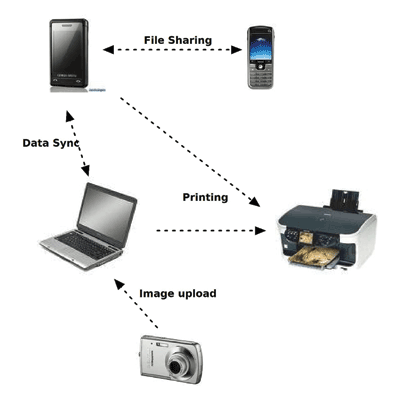Wi-Fi Direct communication aids robotics, automation
Enhancing peer-to-peer communication among embedded systems
BY N. VENKATESH
Vice President, Advanced Technologies
Redpine Signals
www.redpinesignals.com
Wireless networking based on the Wi-Fi IEEE 802.11 standards — thanks to the standardization and branding efforts of the Wi-Fi Alliance (www.wi-fi.org) — is one of the most widely adopted wireless technologies. The network is largely based on a star topology with wireless access points (APs) performing the central function of communicating directly with wireless client devices and providing the link between the wired and wireless part of a network.
Access points today are almost everywhere — in offices, homes, and in a variety of public locations in the form of Wi-Fi hot spots. Wi-Fi client functionality enabled through advanced ICs and software is found in many types of devices and gadgets including notebook computers, cameras, media players, photo frames, TVs, gaming devices, and mobile phones. In an emerging trend, Wi-Fi is being put in embedded systems including medical instruments, security systems, energy management systems, home appliances and factory automation equipment, enabling a wireless “Internet of Things.”
With the widespread availability of APs and hotspots, we may wonder why the Wi-Fi Alliance introduced a peer-to-peer AP-less connectivity. The motivations for this lies in the numerous scenarios where Wi-Fi users would want to connect wirelessly, but are confronted with the nonavailability of an AP infrastructure at their location, or due to lacking of credentials to connect to an AP for carrying out their immediate application.
Peer-to-peer communication
Factory automation applications often have the need to transfer data to and from nearby terminals and for simplicity, reliability, and security reasons may prefer to stay off the building’s wireless network. Wi-Fi Direct can provide low power secure communications over fairly long distances for industrial communications, surveillance equipment, logistics and freight management, and medical patient monitoring and remote diagnostics.

Fig. 1: Wi-Fi Direct consumer usage examples.
Some examples of consumer applications that can be enabled through the availability of a method to connect peer-to-peer are illustrated in Fig. 1 .
Wi-Fi Direct features
The 802.11 Wireless LAN standard already defines a peer-to-peer ad hoc mode also called an independent basic service set (IBSS) mode, which has not been in popular use. The Wi-Fi Direct program has specifically addressed the areas that would enable widespread use of the peer-to-peer mode. These include:
• Security: through WPA2 using AES.
• Ease of security setup through Wi-Fi Simple Configuration (also known as Wi-Fi Protected Setup).
• Connection management through automatic device discovery, support for temporary and persistent network connections, device service management, and optional cross-connection to an infrastructure network.
Wi-Fi Direct also scores over other peer-to-peer protocols such as Bluetooth by providing all standard Wi-Fi benefits of high data rates, long-range operation, IP addressing, and coexistence with neighboring networks.
And in a farsighted move, the Wi-Fi Alliance has incorporated specific requirements into Wi-Fi Direct that enable efficient usage of the wireless network, namely, the prohibition of the use of 802.11b data rates (1, 2, 5.5 and 11 Mbits/s) and of the use of wireless channels in the 2.4-GHz band that are not the “social” channels 1, 6, and 11.
All these features help provide an excellent user experience in the popular usage examples of Wi-Fi Direct. In addition, Wi-Fi Direct can help circumvent the effort and cost involved in installing a wireless infrastructure in an establishment — including site survey, determining the optimal locations and configurations of APs, wiring the APs together and into a gateway, establishing and maintaining security configurations, and allocating channels of operation. Wi-Fi Direct would therefore also be used in greenfield environments where existing or new devices and equipment need to transfer data wirelessly.
Certified and available
Wi-Fi Direct has been defined to be built on top of standard Wi-Fi hardware and software. This has allowed device vendors to quickly bring out certified products. Redpine Signals received Wi-Fi Direct certification for its DirectLINQ module based on its Wi-Fi chipset LiteFi in November 2010; and certification for a DirectLINQ variant based on the Connect-io-n 2.4-GHz 802.11abgn wireless device server family is upcoming.
For example, the RS9110-N-11-22 module is a complete IEEE 802.11bgn-based wireless device server in a 22 x 28-mm module that includes a MAC, baseband processor, RF transceiver with power amplifier, a frequency reference, and an antenna. It has all WLAN protocol and configuration functionality and networking stack in firmware to make a fully self-contained solution. The module features single-supply 3.1 to 3.6-V operation at 40 to 85C.
Redpine modules interface easily to popular MCUs from the company’s partners, which include Cypress Semiconductor, Renesas Electronics America, and Freescale Semiconductor. ■
Advertisement
Learn more about Redpine Signals





